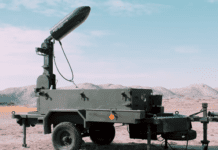This post is also available in:
 עברית (Hebrew)
עברית (Hebrew)
More sensors mean more data. Today’s battlefield is networked with sensors at an unprecedented scale. It is the Internet of Battlefield Things (IoBT) that encompasses drone payloads, video cameras, signal and radio sensors, cyber sensors and scores of other devices. This cohesive network increases situational awareness, risk assessment, and response time. At the tactical level, IoBT networks connect combat gear embedded with biometric wearables to help soldiers identify the enemy, perform better in battle, and access devices and weapons systems using speedy edge computing.
In fact, the global battlefield management systems market will reach $26.24 billion by 2027, with a CAGR growth rate of 6.4% over the period 2019-2027, according to reportlinker.com.
This state of affairs is by and large enabled by artificial intelligence which is increasingly critical for tapping into data acquired by the exploding volume and diversity of sensors as well as to power emerging applications that rely on this data. AI technologies are expected to shift the burden from human to machine so that only the most relevant and timely data reaches those who need it.
According to C4ISRnet.com, AI can make sense of sensor data in six major aspects:
- Video processing with analytics, object and threat detection – for example, the US DoD’s Project Maven has leveraged Google’s TensorFlow AI systems to analyze U.S. drone footage, detect objects of note, and then pass them on to analysts.
- Automated cyber security operations – to maintain an edge over cyber adversaries, tapping AI to automate cyber security operations is critical.
- Sensor fusion, soldier health monitoring, and augmented reality
- EW signal processing and signal intelligence – EW sensors can generate a lot of false signals, or noise. In order to make sense of the data and convert it to actionable information. AI technologies can filter noise and classified signals, reducing the warfighter “cognitive load” when it comes to signal detection.
- Predictive maintenance – to prevent the high costs of military vehicle and equipment breakdowns, sensors can supply real-time AI-based data, e.g. a U.S. Army program which uses AI to improve combat readiness for its fleet of Bradley tanks.
- Battlefield situational awareness and decision support – Advanced Battle Management Systems (ABMS) was designed to connect technology across US military services to better address increasingly sophisticated adversarial threats. The ABMS field test, which linked communications and sensor data collected by Air Force and Navy fighters, a naval destroyer, and an Army unit, is part of a new warfighting concept that envisions coordinated combat that spans the five warfare domains: land, sea, air, space, and cyberspace.
Experts in this field claim that a human still has a role at the battlefield, but the challenges t would be very different from what we have known – his situational awareness, adversary identification capabilities, real-time intelligence, forces location, etc. – all these will be at the tip of his fingers.
Interested in learning more about the role of AI in tactical systems? Attend i-HLS’s InnoTech Expo in Tel Aviv – Israel’s largest innovation, HLS, and cyber technologies expo – on November 18-19, 2020 at Expo Tel Aviv, Pavilion 2.

























